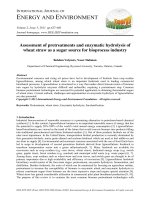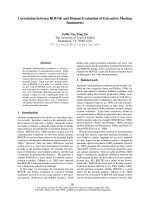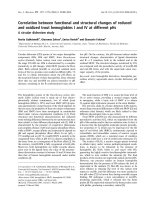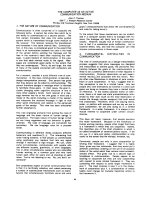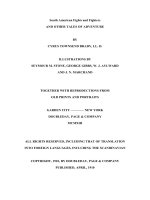The secret war between downloading and uploading tales of the computer as culture machine
Bạn đang xem bản rút gọn của tài liệu. Xem và tải ngay bản đầy đủ của tài liệu tại đây (910.46 KB, 239 trang )
THE SECRET WAR BETWEEN
DOWNLOADING AND UPLOADING
PETER LUNENFELD
THE SECRET WAR BETWEEN
DOWNLOADING AND UPLOADING
TALES OF THE COMPUTER AS CULTURE MACHINE
The MIT Press Cambridge, Massachusetts London, England
© 2011 Massachusetts Institute of Technology
All rights reserved. No part of this book may be reproduced in any form by any electronic or
mechanical means (including photocopying, recording, or information storage and retrieval)
without permission in writing from the publisher.
Designed by Brian Roettinger (Hand Held Heart), Los Angeles
The text was typeset using URW Grotesk, Sabon, and Zinnig.
Printed and bound in the United States of America.
Library of Congress Cataloging-in-Publication Data
Lunenfeld, Peter.
The secret war between downloading and uploading : tales of the computer as culture
machine / Peter Lunenfeld.
p. cm.
Includes bibliographical references and index.
ISBN 978-0-262-01547-9 (hardcover : alk. paper) 1.Computers and civilization.
I. Title.
QA76.9.C66L859 2011
303.48'34—dc22
2010036048
10
9
8
7
6
5
4
3
2
1
For my daughters, Kyra and Maud
CONTENTS
viii
xi
Acknowledgments
Introduction: Three Siblings
p.
p.
p.
p.
p.
Chapter
Chapter
Chapter
Chapter
Chapter
1
13
39
79
97
1
2
3
4
5
Secret War
Sticky
Unimodernism
Web n.0
Bespoke Futures
p. 143
Generations: How the Computer
Became Our Culture Machine
p. 180
p. 198
Notes
Index
ACKNOWLEDGMENTS
This book owes a debt to the theorists, artists, scientists, designers, programmers, architects and poets I was lucky enough to
engage with over the years. Whether through mediawork: The
Southern California New Media Working Group, the Mediawork publishing project, my academic seminars at Art Center
and UCLA, or visiting lectures and critiques, these interactions
helped me construct my models and challenged my preconceptions. I have had wonderful students through the years,
and their receptivity to these ideas when they first were being
formed greatly encouraged me.
A Faculty Enrichment Grant and sabbatical leave from Art
Center College of Design were instrumental in moving this
book from concept to manuscript. I took that sabbatical in
Paris, and it was paradise to have an uninterrupted stretch of
time writing at the Columbia University Institute for Scholars
at Reid Hall. My thanks to Danielle Haase-Dubosc, Mihaela
Bacou and Naby Avcioglu. Back in Los Angeles, Mimi Ito’s
Digital Culture Group meetings at the USC Annenberg Center
for Communications were seminal for refining my arguments.
Art Center’s Media Design Program faculty, especially Anne
Burdick, Andrew Davidson, Denise Gonzales Crisp, Brenda
Laurel, Lisa Nugent and Philip Van Allen, were very supportive
and their work continues to inspire me as to the computer’s
impact on practice. When I moved to the Design Media Arts
department at the University of California, Los Angeles in 2008,
I found congenial colleagues and a welcome new home.
viii
My first year, I was invited to give three linked talks on campus
to introduce my work to the UCLA academic community.
Thanks to Leah Lieverouw of the Information Studies Colloquium, Kenneth Reinhard from the Program in Experimental
Critical Theory, and Todd Presner and Jeffrey Schnapp of the
Mellon Seminar on the Digital Humanities.
Paul Mathias graciously translated and published a long version
of the talk I gave to his seminar in Paris at the College International de Philosophy in their journal Rue Descartes. Other
venues publishing early versions of these ideas included Afterimage, New Media & Society, Los Angeles Times Sunday Book
Review, Think Tank, and Re:Public.
Brian Roettinger of Hand Held Heart has a remarkable vision
of how the book as object and system fits into the contemporary mediascape. Working with him was a reminder that the
best design is not problem solving, it is situation producing.
Chandler McWilliams contributed his expertise and vision to
the electronic versions of the book. At the MIT Press, I continue
to value the contributions of Deborah M. Cantor-Adams.
A special word of thanks for Doug Sery, my long time editor,
who has been so instrumental in building the field of new
media studies. This is the ninth book we’ve worked on over the
past decade, and as ever, he goes far beyond the call of duty.
Friendship sustains you in long projects, and so I want to thank
Doug Hepworth, Dan Harries, Jeff Strauss, Ken Goldberg, Steve
Mamber, Lev Manovich, Geert Lovink and Norman Klein. In the
course of writing this book, my children Kyra and Maud grew
from being delightful kids to insightful teenagers. Watching
them gives me surety that the future will be a better place.
Finally, there’s Susan Kandel, my wife, my toughest editor, my
model for writing. There are not thanks enough in the world
to express what I owe her.
ix
INTRODUCTION
THREE SIBLINGS
X
notes: pp. 180
Sibling Rivalry
I am an only child with three siblings: the bomb, television, and
the computer. I was born in the early 1960s, and these three
have been part of my family for as long as I can remember. All
of them came into the world decades before I did, in the crucible of World War II, but they surged to prominence at different
periods during the second half of the twentieth century. As
we hurtle into the twenty-first, this book is a call for the third
sibling, the computer, to save the family from itself.
The bomb put an end to World War II, but inaugurated both
the cold war and the looming fear that the fate of the earth
hung in the balance. The bomb has been cited as the catalyst
for everything from the rise of existentialism in the 1950s to the
rebirth of religiosity in the West, from atomic age googie diners
in Southern California to the kawai/cuteness of contemporary
Japanese Superflat art. I was a baby when President John F.
Kennedy appeared on all three major television networks to
announce that the Soviets were stationing ballistic missiles just
ninety miles off the Florida coast, and that what was later to
be called the Cuban Missile Crisis was at hand. Kennedy used
the medium of television to talk about the bomb, not only to
the American people, but also to the leadership in Havana
and Moscow, bypassing the customary diplomatic notification
procedures entirely.
The family lore is that my parents stayed up all that night in
terror for themselves and for me. All throughout my college
years, I would occasionally look over my shoulder to see if there
was a vapor trail in the sky pointing the way to atomic apocalypse. The history of the bomb is imprinted in our deepest
reptilian brain; it is a history of fear, mutually assured destruction, and a blinding light followed by darkness.
xi
INTRODUCTION
If the first sibling came out as the biggest bully that the world
had ever seen, what of the next one to emerge on the world
stage? I may not be the best person to answer this question.
A neighbor of mine wrote one of the first antitelevision books,
The Plug-in Drug, and for years my parents didn’t even allow
me to watch the tube. But I outsmarted them, making friends
with kids whose parents were not nearly so averse, and so the
situation comedy double take is as embedded in my DNA as it
is in any other red-blooded American’s—even more so perhaps,
as I eventually, and for reasons still obscure even to myself,
went off to get a PhD in film and television. When I was very
young, television was still something that you could contain,
something that you could cordon off as separate from the rest
of culture. By the time I was an adolescent, however, television had become the dominant medium, the all-encompassing
ether in which everything that seemed to matter—entertainment, sports, news, politics, and even war—was suspended.
Television was not a part of culture by the time I was in my
twenties; it was culture. Television was the entertainer, with its
twitchy history imprinted on our ganglia.
What of the third sibling, that late bloomer, the computer?
While the other two were riding high—the bomb terrifying,
and the tube distracting—the geeky third sibling was biding its
time in university labs and high-end office parks, waiting for its
moment. The famous and probably apocryphal comment from
the 1950s that the world would need no more than a dozen or
so computers points to the slow adoption curve in the general
population. By 1982, though, Time magazine took the odd step
of naming the computer its “Man of the Year” (giving me at
least one excuse for anthropomorphizing these machines). In
the go-go 1990s, those desk-bound machines and lumbering
laptops were being connected into the global network that now
defines the computer as the dominant sibling. This book is an
announcement that the third sibling has truly arrived, and that
xii
THREE SIBLINGS
if we play our cards right, there is a chance that it will not just
eclipse its siblings but instead transform the world that they
made. This is because the computer is the first media machine
that serves as the mode of production (you can make stuff),
means of distribution (you can upload stuff to the network), site
of reception (you can download stuff and interact with it), and
locus of praise and critique (you can talk about the stuff you
have downloaded or uploaded). The computer helps people to
create experiences and offers them spaces—often virtual and
sometimes augmented—to share them.
Think of those fleeting moments when you look out a plane’s
window and realize that regardless of the indignities of contemporary, commercial air travel, you are flying, higher than
a bird, moving through the air itself at hundreds of miles an
hour, an Icarus safe from the sun. Now think of your laptop,
thinner than a manila envelope, or your cell phone, nestled in
the palm of your hand, or better yet, your ear. As computers
get smaller, more ubiquitous, embedded in ever-more quotidian objects, faster, better connected, and easier to use, take
a moment or two to wonder at the marvel.
You are the lucky inheritor of a dream come true.
The second half of the twentieth century saw a collection of
geniuses, warriors, pacifists, cranks, visionaries, entrepreneurs,
great successes, and miserable failures labor to manufacture
a dream machine that could function as a typewriter and printing press, studio and theater, paintbrush and gallery, piano
and radio, the mail as well as the mail carrier. Not only did
they develop just such a device but by the turn of the millennium they also managed to embed it in a worldwide system
accessed by billions of people a day.
xiii
INTRODUCTION
While other technological dreams that sprouted up in the twentieth century—that Popular Mechanics future of flying cars,
robot butlers, and thousand-story skyscrapers—never made it,
this vision of a machine that can simulate any other is now
a widely shared reality. Teenagers watch videos on their cell
phones, ubiquitous grids create wireless hotspots in the middle
of medieval towns, and interactive installations can be found
in galleries worldwide.
The computer is a dream device, the first media machine that
serves as the mode of production, means of distribution, and
site of reception. It is the twenty-first century’s culture machine.
But for all the reasons that there are to celebrate the computer,
we must also tread with caution. This is because we are
engaged in a secret war between downloading and uploading,
and its outcome will shape our collective future in ways we
can only begin to imagine. The promise of the third sibling, the
computer in its guise as culture machine, is to build the feedback loops that keep this a virtuous rather than vicious cycle,
but to do so will entail our taking sides in a secret war that is
already decades old.
Before exploring this secret war, I would like to offer a word
about the structure of this book. Interspersed within the body
of the text are sidebars, offering stories of exemplary people,
objects, and places. Here are synthetic musicals and silk
books, cosmonauts and urbanists, brilliant samplers and the
misguided nephews of genius. These smaller, more personal
narratives will help to ground the theoretical and critical material elsewhere in this book. The question can reasonably be
asked, Why does the critical and theoretical material require
grounding in the personal? I would respond that the kind of
universalized, omniscient theory we associate with the generation of 1968 does not connect with a culture that has been
xiv
THREE SIBLINGS
weaned on Oprah Winfrey’s theater of confession. Winfrey’s
immensely popular television talk show ran for more than
two decades, and within its syndicated, one-hour, afternoon
format, Winfrey championed a relentlessly personal narration
via mass media. By that I mean the ascent of the individual as
creator and promoter of his or her own story, which is often
but not always a narrative of redemption through suffering.
The Oprahization of discourse has seen the decline of disembodied experience and ascendance of the memoir. Adjusting to
the expectations of audience for the personal and the detailed
is not, in the end, such a bad thing (perhaps the personal is
political after all, and maybe even theoretical).
In addition to the main arguments and these sidebars, there is
a third component to this book: a historical narrative that offers
a generational history tackling the story of how the computer
became our culture machine. The “Generations” section can be
read before, during, or after the rest of the book. Like the sidebars, the historical narrative concentrates on personal stories,
with two figures from each generation discussed at length, and
a concentration on the ways in which the memes of simulation
and participation developed and intertwined over the years.
The first generation, the Patriarchs, established these foundational memes in the early years after World War II. They
were followed by the Plutocrats, who turned computing into
a business during the 1950s and 1960s. In opposition to the
profit-minded Plutocrats, the 1960s and 1970s brought us the
Aquarians, who proposed the visual, personalized, networked
computers. In the 1980s and 1990s, the Hustlers took this
vision and turned it into a commodity, getting it on to desktops
worldwide. The next generation, that of the Hosts, connected
these machines together into a truly World Wide Web, and
pushed participation to the next level. We are now living
through the sixth generation, that of the Searchers. For this
generation, the wealth of information produced by the braiding
xv
INTRODUCTION
of simulation and participation is so great that merely finding
our way through the morass has become a signature quality
of our engagement with the culture machine.
While the sidebars and “Generations” concentrate on people
and discrete objects and systems, the body of the book engages
with more overarching investigations that generate not just
new findings but also new ways of talking about these findings. The pages that follow play with language, with pairings
meant to establish complementary and oppositional relationships, like the central “downloading/uploading” coupling, along
with “meaningful/mindful” as well as “tweak/toggle,” “power/
play,” “simulation/participation,” and “figure/ground.” In these
pages, there are also concepts that I proposed over a decade
ago and am pondering still, such as “unfinish,” “hypercontexts,”
and the computer as our “culture machine.” Even newer words
and phrases had to be coined just for the arguments presented
here, like “Web n.0,” “R-PR” (really public relations), “MaSAI”
(or Massively Public Applications of the Imagination), “bespoke
futures,” “89/11,” and “info-triage.” Also present is the appropriation of language that happens when you scour science for
concepts like “strange attractors,” or when you create portmanteaus such as “plutopian meliorism” and posit that we can
now speak of the “Enlightenment Electrified.” Then there is the
final issue of what kind of language differentiation you need
to use in the face of a hybridizing hegemony of “unimodern
unimedia.”
Of special note in this book is the period between 1989 and
2001, in which all three siblings reached something of a tipping
point. After the Berlin Wall came down and the sense of nuclear
menace diminished, I stopped looking over my shoulder for the
first time, expecting clear skies without vapor trails. But the
events of 9/11 transformed the H-bomb into the human bomb,
and the specific threat of death from the sky transformed itself
xvi
THREE SIBLINGS
into a free-floating anxiety about weapons of mass destruction and terror. At that point, television refined new ways of
marketing fear as entertainment in a twenty-four-hour news
cycle, and the worst excesses of the blogosphere simulated
this model, accelerating it into the viral torrent of RSS feeds
to mobile phones and “the new” at the click of the browser’s
refresh button. When fear or its inverse—empty-headed distraction—become the default content, the secret war between
downloading and uploading is well on the way to being lost.
This book offers a warning, because if the bomb is the bully and
the television is the entertainer, the computer is the family’s
mimic. And if the computer chooses to model its behavior after
its siblings, we will be in worse shape than ever. This mimicry,
or simulation as it is better termed, comes to us from the
computer’s very origins and will define its future. But should
we push the computer to its limitless limits, taking advantage
of its capacity to enable participation, we may well be able to
address some of the key problems we face and make the first
half of the twenty-first century more livable than the second
half of the last one.
xvii
CHAPTER ONE
SECRET WAR
X
notes: pp. 180–182
Humans Upload
First, we must define the terms of the struggle.
Downloading means pulling data into a system, and connotes
moving information from a main or central source to a peripheral device. Uploading, by contrast, carries associations of
moving data not only from a periphery to a core but also from
one device to many, flattening out the hierarchy of production,
distribution, and reception.1
All animals download, but only a few upload anything besides
shit and their own bodies. Beavers build dams, birds make
nests, and termites create mounds, yet for the most part, the
animal kingdom moves through the world downloading and
then munching it bits at a time.
Humans are unique in their capacity to not only make tools but
then turn around and use them to create superfluous material
goods—painting, sculpture, and architecture—and superfluous experiences—music, literature, religion, and philosophy.
Of course, it is precisely the superfluous that then comes to
define human culture and ultimately what it is to be human.
Understanding and consuming culture requires great skills (ask
anyone who has taught a child to read), but failing to move
beyond downloading is to strip oneself of a defining constituent of humanity.
For all the wonders of the present moment, a cultural hierarchy persists. Even after the advent of widespread social media
sites, a pyramid of production remains, with a small number
of the members of a Web community uploading material,
a slightly larger group commenting on or modifying that
content, and a huge percentage remaining content to download without uploading.2 One reason for the persistence of this
1
CHAPTER 1
pyramid of production is that like countries or peoples, different media have their own unique cultures. I would maintain
that for the past half century, first the United States’ and then
much of the West’s culture has been defined by television, and
television is defined by downloading.
Television as a media system involves taking in images and
sounds produced by others. It does not matter if it is delivered
over the air, via cable, or with the aid of a dish; played back
from tape, digital video disc (DVD), or a digital video recorder’s (DVR) hard drive; watched on a plasma screen, an ancient
console, or in the car (a particularly terrifying development for
those of us who drive the freeways). Television is always the
same: to watch it is to track an electronic download in real
time—a narrativized progress bar with a laugh track.3 Marshall
McLuhan was half right: the medium is the message, but the
messages also define the medium.
And what of the computer? The challenge it has mounted
to television over the past decade has little to do with one
machine being replaced by another—in the manner of 78s
being supplanted by LPs, vinyl records by 8-tracks and cassette
tapes, and compact discs (CDs) by MP3s; or videotape recorders by laser discs to be followed in turn by DVDs, video on
demand, and DVRs. The challenge is far more profound than
that. The computer, remember, is a machine that can upload
anything its users make, and then distribute them either one to
one or one to many, affording a radical break from the culture
of television. But the computer also has the unique capacity
for simulation, and it is this capacity—however perversely—that
imperils its potential, because it can be better and faster at
downloading than television ever was.
Let us turn for a moment to the cultural inheritance of television’s half century of dominance.
2
SECRET WAR
Cultural Diabetes
The destiny of nations depends on the manner in which they are fed.
—Jean Anthèlme Brillat-Savarin
For diabetes sufferers, the body cannot create enough insulin
to process the sugar that it has taken in: there is an imbalance between consumption and production. Diabetes is to
a large extent a disease of plentitude, the result of obesity and
the overconsumption of calories.4 It is hardly news that we
have been fattened up by a food industry that values novelty
over nutrition and profits over public health. But in terms of our
media consumption, we are in a diabetic coma as well.
The kind of diabetes I am refering to here is not type 1 (insulin-dependent or juvenile-onset) but rather type 2 (adult-onset)
diabetes, which in past years has been hitting people at younger
and younger ages. This type of diabetes is, in fact, largely treatable without drugs. A large portion of the affected population
can keep their blood sugars in a healthy range without oral
medications or injecting insulin if they follow an exercise plan,
and eat in a way that controls the size of their portions and
spreads out the amount of carbohydrates consumed throughout the course of the day.5 In other words, the cure is under the
individual’s control, but individuals have to take responsibility
for their own care by adopting a new rigor.
There are many conflicting theories about the massive increase
in the weight, waistlines, caloric intakes, and incidence of
diabetes in all age groups in the developed West. One thing
all agree on is the confluence of syndromes, many of which are
out of the individual’s capacity to control. These include the
shift from manual labor to desk jobs, from pedestrian cities
to automobile suburbs, from home-cooked meals to restaurant
or “take-home” consumption, and the tendency to “supersize”
3
CHAPTER 1
portions as a way to entice consumers into purchasing. But
I have been attracted to one hypothesis that points to the
adoption of high fructose corn syrup (HFCS) as the food industry’s sweetener of choice over the past few decades.
For untold centuries, if humans ate something cooked that was
sweet, it tended to be made with either cane or beet sugars.
Starting in the 1970s, though, agribusiness invested heavily
in shifting to a corn-based sweetener solution.6 This worked
spectacularly well for the food industry because corn syrup
was much cheaper to produce, which allowed for heavily
sweetened products to be maintained at very low price points.
By the mid-1980s, almost all soft drinks, mass-produced bakery
products, candies, and the like had shifted to HFCS. The move
to corn sweeteners made the combination of a foot-long
microwave cinnamon churro and a forty-eight-ounce Mountain Dew Slurpee® not just affordable but instead downright
cheap. Supersizing has become not just one potentially viable
economic model; it is increasingly the only economic model.
The increasing availability of inexpensive high-calorie foods
means that hunger is disappearing in low-income communities.
Yet at precisely the same moment, diabetes-related problems
are growing. So too the proliferation of ever-more opportunities to download is a gift that must be treated with care.
The ability to connect to networks at all times from anywhere
can be a boon as well as an increasingly global promise that
people can access the information they need. But the development of capitalism over the past half century was predicated
on shifting patterns of consumption to concentrate on wants
rather than needs. As a result, downloading has become yet
more firmly intertwined with consumption.
These transformations are cultural, to be sure, yet they also
rest on technological bases. Most commercial networks have
4
SECRET WAR
radically slower speeds to upload material than to download
it. So pervasive are these differences that numerous Web sites
have come into existence that provide tools to measure them—
important metrics for those who upload for a living to evaluate
service providers. These disparities are not in and of themselves an insurmountable problem, but the infrastructure does
build in a bias against the culture machine’s capacity to upload.
This bias brings us back to the metaphor of cultural diabetes.
Created like colas and burgers by multinational conglomerates,
the junk culture of broadcasting creates a nation of intellectual
diabetics. The cure is in our collective grasp. It involves controlling and rationing our intake (downloading), and increasing our
levels of activity (uploading.) Not to break it down too much
like a junior-year hygiene class, but what I am saying here is
that watching is ingesting is downloading and that making is
exercising is uploading. This project, then, sets as its purpose
the identification of a new culture machine for the twenty-first
century—one that uses digital technologies to shift us from
a consumption to a production model.
T
SIDEBAR
Ragazzi at Pizza Hut
Why are Roman teenagers eating at McDonald’s and Pizza Hut,
and what can patriotic Italians do to stop them? If marketing
campaigns and the lure of the exotic convinced these ragazzi to
scarf down frozen, prefab, meat-and-cheese-product-bedecked
circles and triangles of carbohydrates, what hope might there
be for the future of one of the world’s most spectacular culinary heritages? When Carlo Petrini watched a McDonald’s open
in Rome in 1986, he understood that for Roman youth, U.S.
fast food was both a symbol of modernity and an emblem of
5
CHAPTER 1
solidarity with teenagers the world over. Rather than merely
wringing his hands, however, Petrini decided to take action.
Bringing together foodies with anti-globalists, cultural traditionalists, and those who wanted to buy from local producers
rather than multinational conglomerates, Petrini started what
has come to be known as the Slow Food movement.
The central concept of Slow Food is that eating is part of
an interlinked cultural system of production and consumption—gastronomy, in a word. The Slow Food movement is
a rebuke to mechanistic visions of food as a commodity. The
movement insists that when food is reduced to either fuel or
instant gratification, people lose touch with the ways in which
the practice of cooking and eating can become a way of life,
a mode of culture. In this reconnection with the importance
of daily practice, the slow food movement serves as a model
for anyone who wants to think of moving out of a cycle of
consumption for consumption’s sake to one in which consumption is enmeshed in practices of production as well.
In the slow food movement, which has spread worldwide and
now claims three-quarters of a million adherents, the rigors
of learning to cook along with carving out the time for it are
rewarded by the social interaction with the family, friends,
and neighbors with whom one shares the experience. Beyond
my own preference for gnocchi over nuggets, the slow food
movement can serve as a model of resistance to television’s
junk culture more than the usual call for alternative, independent, community, and activist media (though it is interesting
to note that Petrini himself comes out of leftist political media,
having founded the first independent radio station in Italy). Its
appeal may be the immediacy of food’s place and moment
of consumption in relation to production, and the surety that
people have that the food they make will have an audience (all
but the worst cooks will be able to find someone to eat what
6
